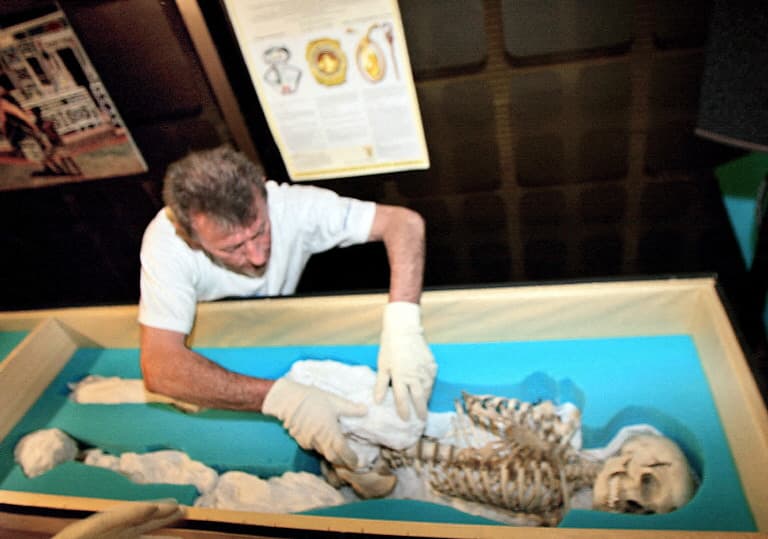France paves way to repatriating more human remains from museums

France's parliament has passed a bill that paves the way towards human remains contained in its museum collections being repatriated to their countries of origin for burial.
The law, which received its final approval in the upper house Senate late on Monday, is the culmination of years of debate on the ethics of keeping human body parts in French cultural inventories.
It allows for certain remains of people deceased after the year 1500 to be extracted from museum collections by decree to be returned home to their descendants for "funeral purposes".
"It's a historic moment awaited by several foreign peoples," said Culture Minister Rima Abdul Malak.
She said she hoped the decision would allow some reconciliation, as remains "sometimes entered our collections after having been acquired illegitimately or even violently".
The bill is to facilitate France returning the human remains of Aboriginals to Australia, as well as the skeleton of an indigenous Tehuelche chief to his descendants in Argentina.
Madagascar has asked for three skulls of its Sakalava people to be brought home, including one it says is that of a king decapitated in 1897 during an attack by French colonial forces to quash a rebellion.
Several hundred French institutions, including museums and universities, are thought to have human remains in their collections.
Until now only two exceptional laws had been passed to allow repatriations to South Africa and New Zealand.
In 2002, France returned the remains of Saartjie Baartman, the "Hottentot Venus", to South Africa to be buried.
Baartman, a member of the indigenous Khoisan community, was taken from her homeland in 1810 by a British ship's doctor who told her she could earn a fortune in Europe by allowing foreigners to look at her body.
She was paraded in Britain and France for years as a sexual freak because of her large buttocks and genitalia, before she died a pauper in Paris in 1815.
After her death, her body was dissected and her skeleton, skull and genitalia displayed in Paris' Museum of Mankind until 1974.
In 2010, France's parliament also approved returning around 15 mummified and elaborately tattooed heads of Maori warriors to New Zealand.
The French law to return the mummified heads marked the end of a long battle by New Zealand's Maori community to bring their ancestors home from France.
Authorities in the western city of Rouen authorities decided to give one such head back in 2007, but the government overruled the decision, fearing it would set a precedent for other museum holdings, such as Egyptian mummies or relics of Christian martyrs.
Comments
See Also
The law, which received its final approval in the upper house Senate late on Monday, is the culmination of years of debate on the ethics of keeping human body parts in French cultural inventories.
It allows for certain remains of people deceased after the year 1500 to be extracted from museum collections by decree to be returned home to their descendants for "funeral purposes".
"It's a historic moment awaited by several foreign peoples," said Culture Minister Rima Abdul Malak.
She said she hoped the decision would allow some reconciliation, as remains "sometimes entered our collections after having been acquired illegitimately or even violently".
The bill is to facilitate France returning the human remains of Aboriginals to Australia, as well as the skeleton of an indigenous Tehuelche chief to his descendants in Argentina.
Madagascar has asked for three skulls of its Sakalava people to be brought home, including one it says is that of a king decapitated in 1897 during an attack by French colonial forces to quash a rebellion.
Several hundred French institutions, including museums and universities, are thought to have human remains in their collections.
Until now only two exceptional laws had been passed to allow repatriations to South Africa and New Zealand.
In 2002, France returned the remains of Saartjie Baartman, the "Hottentot Venus", to South Africa to be buried.
Baartman, a member of the indigenous Khoisan community, was taken from her homeland in 1810 by a British ship's doctor who told her she could earn a fortune in Europe by allowing foreigners to look at her body.
She was paraded in Britain and France for years as a sexual freak because of her large buttocks and genitalia, before she died a pauper in Paris in 1815.
After her death, her body was dissected and her skeleton, skull and genitalia displayed in Paris' Museum of Mankind until 1974.
In 2010, France's parliament also approved returning around 15 mummified and elaborately tattooed heads of Maori warriors to New Zealand.
The French law to return the mummified heads marked the end of a long battle by New Zealand's Maori community to bring their ancestors home from France.
Authorities in the western city of Rouen authorities decided to give one such head back in 2007, but the government overruled the decision, fearing it would set a precedent for other museum holdings, such as Egyptian mummies or relics of Christian martyrs.
Join the conversation in our comments section below. Share your own views and experience and if you have a question or suggestion for our journalists then email us at [email protected].
Please keep comments civil, constructive and on topic – and make sure to read our terms of use before getting involved.
Please log in here to leave a comment.